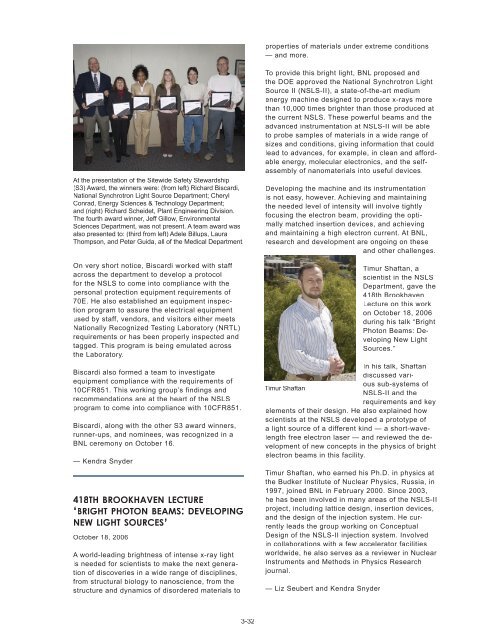NSLS Activity Report 2006 - Brookhaven National Laboratory
NSLS Activity Report 2006 - Brookhaven National Laboratory
NSLS Activity Report 2006 - Brookhaven National Laboratory
Create successful ePaper yourself
Turn your PDF publications into a flip-book with our unique Google optimized e-Paper software.
At the presentation of the Sitewide Safety Stewardship<br />
(S3) Award, the winners were: (from left) Richard Biscardi,<br />
<strong>National</strong> Synchrotron Light Source Department; Cheryl<br />
Conrad, Energy Sciences & Technology Department;<br />
and (right) Richard Scheidet, Plant Engineering Division.<br />
The fourth award winner, Jeff Gillow, Environmental<br />
Sciences Department, was not present. A team award was<br />
also presented to: (third from left) Adele Billups, Laura<br />
Thompson, and Peter Guida, all of the Medical Department.<br />
On very short notice, Biscardi worked with staff<br />
across the department to develop a protocol<br />
for the <strong>NSLS</strong> to come into compliance with the<br />
personal protection equipment requirements of<br />
70E. He also established an equipment inspection<br />
program to assure the electrical equipment<br />
used by staff, vendors, and visitors either meets<br />
<strong>National</strong>ly Recognized Testing <strong>Laboratory</strong> (NRTL)<br />
requirements or has been properly inspected and<br />
tagged. This program is being emulated across<br />
the <strong>Laboratory</strong>.<br />
Biscardi also formed a team to investigate<br />
equipment compliance with the requirements of<br />
10CFR851. This working group’s findings and<br />
recommendations are at the heart of the <strong>NSLS</strong><br />
program to come into compliance with 10CFR851.<br />
Biscardi, along with the other S3 award winners,<br />
runner-ups, and nominees, was recognized in a<br />
BNL ceremony on October 16.<br />
— Kendra Snyder<br />
418TH BROOKHAVEN LECTURE<br />
‘BRIGHT PHOTON BEAMS: DEVELOPING<br />
NEW LIGHT SOURCES’<br />
October 18, <strong>2006</strong><br />
A world-leading brightness of intense x-ray light<br />
is needed for scientists to make the next generation<br />
of discoveries in a wide range of disciplines,<br />
from structural biology to nanoscience, from the<br />
structure and dynamics of disordered materials to<br />
3-32<br />
properties of materials under extreme conditions<br />
— and more.<br />
To provide this bright light, BNL proposed and<br />
the DOE approved the <strong>National</strong> Synchrotron Light<br />
Source II (<strong>NSLS</strong>-II), a state-of-the-art medium<br />
energy machine designed to produce x-rays more<br />
than 10,000 times brighter than those produced at<br />
the current <strong>NSLS</strong>. These powerful beams and the<br />
advanced instrumentation at <strong>NSLS</strong>-II will be able<br />
to probe samples of materials in a wide range of<br />
sizes and conditions, giving information that could<br />
lead to advances, for example, in clean and affordable<br />
energy, molecular electronics, and the selfassembly<br />
of nanomaterials into useful devices.<br />
Developing the machine and its instrumentation<br />
is not easy, however. Achieving and maintaining<br />
the needed level of intensity will involve tightly<br />
focusing the electron beam, providing the optimally<br />
matched insertion devices, and achieving<br />
and maintaining a high electron current. At BNL,<br />
research and development are ongoing on these<br />
and other challenges.<br />
Timur Shaftan, a<br />
scientist in the <strong>NSLS</strong><br />
Department, gave the<br />
418th <strong>Brookhaven</strong><br />
Lecture on this work<br />
on October 18, <strong>2006</strong><br />
during his talk “Bright<br />
Photon Beams: Developing<br />
New Light<br />
Sources.”<br />
In his talk, Shaftan<br />
discussed various<br />
sub-systems of<br />
Timur Shaftan<br />
<strong>NSLS</strong>-II and the<br />
requirements and key<br />
elements of their design. He also explained how<br />
scientists at the <strong>NSLS</strong> developed a prototype of<br />
a light source of a different kind — a short-wavelength<br />
free electron laser — and reviewed the development<br />
of new concepts in the physics of bright<br />
electron beams in this facility.<br />
Timur Shaftan, who earned his Ph.D. in physics at<br />
the Budker Institute of Nuclear Physics, Russia, in<br />
1997, joined BNL in February 2000. Since 2003,<br />
he has been involved in many areas of the <strong>NSLS</strong>-II<br />
project, including lattice design, insertion devices,<br />
and the design of the injection system. He currently<br />
leads the group working on Conceptual<br />
Design of the <strong>NSLS</strong>-II injection system. Involved<br />
in collaborations with a few accelerator facilities<br />
worldwide, he also serves as a reviewer in Nuclear<br />
Instruments and Methods in Physics Research<br />
journal.<br />
— Liz Seubert and Kendra Snyder

















